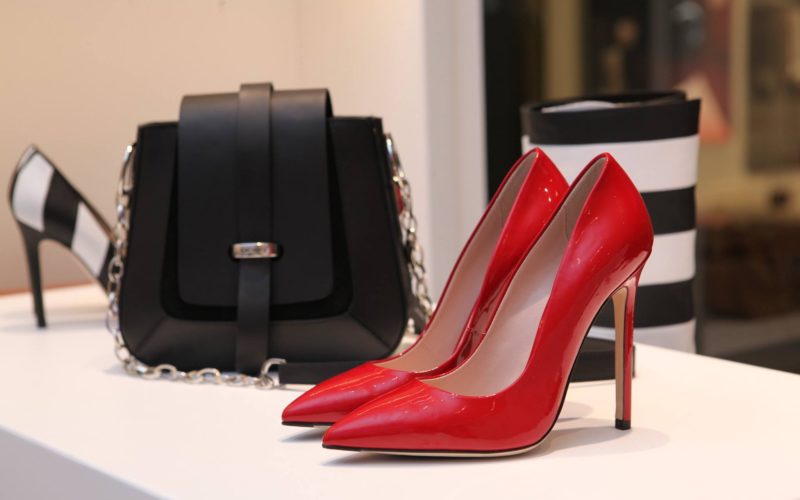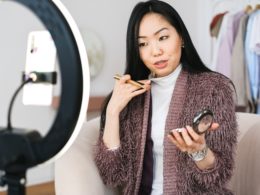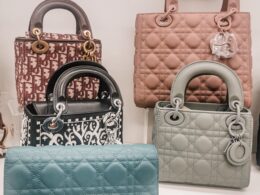The fashion industry relies on intellectual property protections, including trademarks, to protect and distinguish its brands. Likewise, trademarks are integral to brands’ identity and recognition, from the intertwined “LV” on a Louis Vuitton handbag to the red bottoms of Christian Louboutin pumps. Trademark law protects designers’ creations in a competitive industry thriving on knockoffs and gives the brand’s representatives a legal remedy to counterfeiting.1[1]1Sharon Urias, Comparing Trademark Issues in Very Different Industries: Fashion, Cannabis, High-tech, Reuters, November 21, 2022. https://www.reuters.com/legal/litigation/comparing-trademark-issues-very-different-industries-fashion-cannabis-high-tech-2022-11-21/. Further, trademarks protect consumers by ensuring that when they buy a bag with “double C’s,” they are purchasing the expected authentic Chanel handbag, fostering coveted brand loyalty in the process. Brands’ reputations may suffer when a third-party trademark infringement compromises that trust.
Motivated by sustainability and affordability concerns, the younger generation’s shopping habits have migrated from buying designer items in-store to resale platforms. 2[2]2 Drishti Arora, Shift to Secondhand Fashion, Fashion Law Journal, August 23, 2021. https://fashionlawjournal.com/shift-to-secondhand-fashion/. However, counterfeit products have infiltrated this resale system: naïve owners unknowingly attempt to resell knockoff items or intentional infringers hope to profit from counterfeit goods that slipped past the authentication stage of the resale scheme. While brands have implemented systems to protect against counterfeit confusion, these are not always successful, leading to increased litigation.
ORLI and Stolen Serial Numbers
Chanel, a leading luxury fashion house, serves as an example of the importance of trademark and brand protection practices. To safeguard product authenticity, Chanel employs an internal record system called “ORLI” to track bags at every phase of production.3[3]Chanel, Inc. v. WGACA, LLC, 1:18-cv-02253 at 32 (SDNY). Every Chanel-branded product is given a unique Chanel Serial Number and Authenticity Card upon meeting quality requirements.4[4]Id. at *5. The ORLI system confirms genuine Chanel products by cross-referencing the product’s color, type, and characteristics with the details of the genuine product associated with that specific serial number.5[5]Id. This method aims to ensure a comprehensive verification process to ultimately maintain the integrity of Chanel’s luxury brand and prevent counterfeits.6[6]Id.
In November 2012, an unidentified individual stole 30,000 labels, stickers, and Authenticity Cards from Chanel’s Renato Corti factory in Milan, Italy.7[7]Id. at *4. When serial numbers are missing or stolen this way, Chanel voids them within the ORLI System to maintain the security of its product authentication.8[8]Id. at *5. However, that process did not work as expected, and the incident caused significant issues for Chanel, as the stolen serial numbers were then paired with counterfeit goods sold as authentic Chanel products, some of which entered the resale market.9[9]Id.
Chanel v. WGACA
In 2018, Chanel initiated legal proceedings against What Goes Around Comes Around (“WGACA”), a New York-based retailer of secondhand luxury goods.10[10]Id. at *1-2. Chanel’s original complaint included five causes of action against the resale brand: trademark infringement, false association and endorsement, and false advertising.11[11]Id. Chanel claims WGACA practices caused actual confusion in the marketplace, leading consumers to believe Chanel was affiliated with WGACA and involved in their authentication processes.12[12]Id. at *35. Marketplace confusion poses a significant concern for Chanel because any failure in WGACA’s authentication practices may mistakenly implicate Chanel by potentially harming its reputation among consumers.
Some of Chanel’s trademark infringement and false association claims against WGACA stemmed from the stolen Serial Numbers from the Renato Corti factory and the ORLI System.13[13]Id. at *7-8. These claims revolve around WGACA selling/offering for sale of four types of products bearing Chanel trademarks.14[14]Id.
A notable issue at trial was the definition of a counterfeit good. Ahead of jury deliberation, Chanel objected to the court’s jury instruction distinguishing between a counterfeit and non-genuine Chanel branded product.15[15] Brief re: Jury Instruction on Meaning of Counterfeit, Chanel, Inc. v. WGACA, LLC, (2024) (No. 1:18-cv-02253-LLS). The court instructed, “[I]f it’s not made in a Chanel-authenticated factory, it is not a genuine Chanel. It is a counterfeit if it is so like a Chanel that it’s hard to tell the difference. In other words, [a] counterfeit must be a copy.”16[16]Id.
Chanel took issue with this distinction, citing precedent in Chrome Hearts LLC v. Controse Inc.17[17]Id. where the court opined that “counterfeit analysis looks to the similarity of the marks to determine whether enhanced relief is available, and not to the similarity of the goods or products to which the mark is attached.”18[18] Chrome Hearts LLC v. Controse Inc., 21-cv-6858 (LJL), at 9, 2023 WL 5049198. This definition focuses on the marks themselves rather than the product’s origin, as emphasized in the court’s jury instruction.
WGACA contended that Chanel’s lawsuit impeded the lawful sale of its products and that its use of the Chanel trademark was solely for product identification purposes, amounting to nominative fair use, and did not directly imply affiliation with Chanel.19[19]Id. In its defense against the
trademark infringement and false association claims, WGACA countered Chanel’s assertion that only bags passing through the ORLI system can be considered genuine.20[20]20 Chanel v. What Goes Around Comes Around: Timeline of a Resale Case, The Fashion Law, April 19, 2024, https://www.thefashionlaw.com/chanel-v-what-goes-around-comes-around-timeline-of-a-resale-lawsuit/. WGACA asserted that not all of Chanel’s products undergo inspection and, consequently, might not be marked within the ORLI system in the first place.21[21]Id. While WGACA additionally argued several affirmative defenses, including laches and lack of an appropriate remedy, the court ultimately disagreed.22[22]Id. at *35. The court noted that Chanel acted without undue delay, thus negating the basis of WGACA’s laches defense and concluding that equitable remedies of disgorgement of profits or injunction were appropriate for Chanel.23[23]Id.
After an 18-day trial, the jury ruled in favor of Chanel on all claims, awarding Chanel $4 million in statutory damages.24[24] Jury Verdict Form, Chanel, Inc. v. WGACA, LLC, (2024) (No. 1:18-cv-02253-LLS). The court held that WGACA acted “willfully, with reckless disregard, or with willful blindness” in reselling these counterfeit products.25[25]Id. In March of 2024, Chanel sought a permanent injunction and disgorgement of company profits and asked WGACA to display a disclaimer of affiliation and authorization. The second phase of this trial will occur on July 15, 2024, to decide the equitable remedies for Chanel.26[26] Chanel v. What Goes Around Comes Around: Timeline of a Resale Case, The Fashion Law, April 19, 2024, https://www.thefashionlaw.com/chanel-v-what-goes-around-comes-around-timeline-of-a-resale-lawsuit/.
Only the Beginning
While Chanel may have won this trial, other trademark disputes persist for the prestigious fashion house. Chanel is involved in a similar lawsuit against another well-known luxury consignment retailer, The RealReal.
Even after the first sale, resellers must diligently avoid reselling counterfeit goods and be mindful of their product branding. Likewise, as discussions of sustainability, the allure of vintage products, and shopping habits of the younger generation evolve, luxury brands like Chanel must protect their intellectual property while staying current with trends of secondhand consumerism. In this dynamic marketplace, consumers seeking the quality and prestige of a luxury product through the resale market should be cautious to ensure the authenticity and integrity of their purchases before swiping their cards.
By: Olivia Dinkins
Olivia Dinkins is a 2026 J.D. Candidate at Brooklyn Law School




